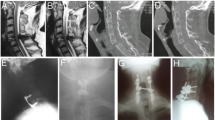Abstract
Purpose
This report describes the characteristics of conservative cases with a coronally oriented vertical fracture of the posterior region of the C2 vertebral body.
Methods
Eight consecutive patients with a coronally oriented vertical fracture of the posterior region of the axis body who received conservative treatment were retrospectively reviewed. All the patients were male. The average patient age at injury was 71.4 years. The medical records of the patients were reviewed, and we identified the fractures associated with the cervical spine, other associated spinal fractures and the details of conservative treatment.
Results
Six patients had associated cervical spinal fractures, such as Jefferson fractures in four cases, spinous process fractures of the lower cervical spine in two cases, a teardrop fracture in one case and a unilateral spinous process fracture of C2 in one case. Two patients had associated spinal fractures in the thoracic spine. All the patients acquire solid bony fusion, including fusion of the associated cervical spinal fractures.
Conclusions
The patients with a coronally oriented vertical fracture of the posterior region of the C2 vertebral body consisted were all elderly males in our study. Six of the eight patients demonstrated associated cervical spinal fractures; however, all patients acquired solid bony union, including fusion of the associated cervical spinal fractures. We suggest that a Philadelphia collar may be sufficient for conservatively treating coronally oriented vertical C2 body fractures, including associated cervical spinal fractures.


Similar content being viewed by others
References
Burke JT, Harris JH Jr (1989) Acute injuries of the axis vertebra. Skelet Radiol 18:335–346
Greene KA, Dickmann CA, Marciano FF, Drabier JB, Hadley MN, Sonntag VK (1997) Acute axis fracture. Spine 22:1843–1852
Denaro V, Papalia R, Di Martino A, Denaro L, Maffulli N (2011) The best surgical treatment for type II fractures of the dens is still controversial. Clin Orthop Relat Res 469:742–750
Francis WR, Fielding JW, Hawkins RJ, Pepin JW, Hensinger R (1981) Traumatic spondylolisthesis of the axis. J Bone Joint Surg Br 63-B:313–318
Effendi B, Roy D, Cornish B, Dussault RG, Laurin CA (1981) Fractures of the ring of the axis. A classification based on the analysis of 131 cases. J Bone Joint Surg Br 63-B:319–327
Pepin JW, Hawkins RJ (1981) Traumatic spondylolisthesis of the axis: Hangman’s fracture. Clin Orthop Relat Res 157:133–138
Levine AM, Edwards CC (1985) The management of traumatic spondylolisthesis of the axis. J Bone Joint Surg Am 67:217–226
Coric D, Wilson JA, Kelly DL Jr (1996) Treatment of traumatic spondylolisthesis of the axis with nonrigid immobilization: a review of 64 cases. J Neurosurg 85:550–554
Müller EJ, Wick M, Muhr G (2000) Traumatic spondylolisthesis of the axis: treatment rationale based on the stability of the different fracture types. Eur Spine J 9:123–128
Vaccaro AR, Madigan L, Bauerle WB, Blescia A, Cotler JM (2002) Early halo immobilization of displaced traumatic spondylolisthesis of the axis. Spine 27:2229–2233
Benzel EC, Hart BL, Ball PA, Baldwin NG, Orrison WW, Espinosa M (1994) Fractures of the C2 vertebral body. J Neurosurg 81:206–212
Fujimura Y, Nishi Y, Kobayashi K (1996) Classification and treatment of axis body fractures. J Orthop Trauma 10:536–540
German JW, Hart BL, Benzel EC (2005) Nonoperative management of vertical C2 body fracture. Neurosurgery 56:516–521
Zhang YS, Zhang JX, Yang QG, Shen CL, Li W, Yin ZS (2014) Surgical management of the fractures of axis body: indications and surgical strategy. Eur Spine J 23:1633–1640
Iizuka H, Shimizu T, Hasegawa W, Takagishi K (2001) Fractures of the posterior part of the body and unilateral spinous process of the axis: a case report. Spine 26:E528–E530
Longo UG, Denaro L, Campi S, Maffulli N, Denaro V (2010) Upper cervical spine injuries: indications and limits of the conservative management in Halo vest. A systematic review of efficacy and safety. Injury 41:1127–1135
Author information
Authors and Affiliations
Corresponding author
Ethics declarations
Conflict of interest
The authors have no financial conflicts of interest.
Rights and permissions
About this article
Cite this article
Iizuka, H., Tomomatsu, Y., Sorimachi, Y. et al. Clinical findings of conservative cases with a coronally oriented vertical fracture of the posterior region of the C2 vertebral body. Eur Spine J 25, 110–114 (2016). https://doi.org/10.1007/s00586-015-4187-4
Received:
Revised:
Accepted:
Published:
Issue Date:
DOI: https://doi.org/10.1007/s00586-015-4187-4




